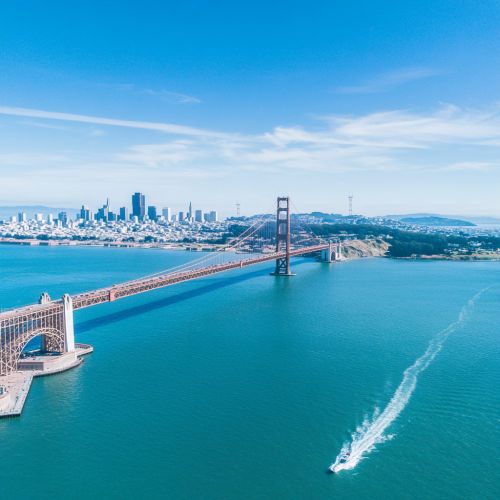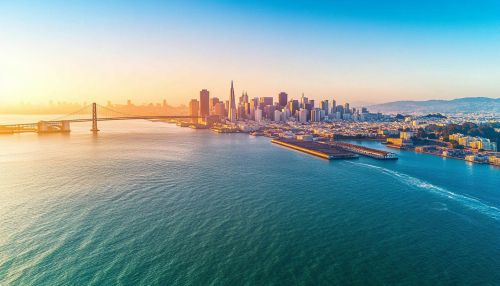San Francisco Bay: Difference between revisions
(Created page with "==Geographical Overview== The San Francisco Bay is a complex estuarine system located in Northern California, United States. It is a shallow, productive estuary that serves as the outlet for the waters of the Sacramento River and the San Joaquin River, which flow from the Central Valley. The bay is connected to the Pacific Ocean by the narrow Golden Gate strait, which is approximately 1.6 kilometers wide. This unique geographi...") |
No edit summary |
||
| (One intermediate revision by the same user not shown) | |||
| Line 3: | Line 3: | ||
The San Francisco Bay is a complex estuarine system located in Northern California, United States. It is a shallow, productive estuary that serves as the outlet for the waters of the [[Sacramento River]] and the [[San Joaquin River]], which flow from the [[Central Valley (California)|Central Valley]]. The bay is connected to the Pacific Ocean by the narrow [[Golden Gate]] strait, which is approximately 1.6 kilometers wide. This unique geographical feature has made the bay a crucial hub for maritime activities and ecological diversity. | The San Francisco Bay is a complex estuarine system located in Northern California, United States. It is a shallow, productive estuary that serves as the outlet for the waters of the [[Sacramento River]] and the [[San Joaquin River]], which flow from the [[Central Valley (California)|Central Valley]]. The bay is connected to the Pacific Ocean by the narrow [[Golden Gate]] strait, which is approximately 1.6 kilometers wide. This unique geographical feature has made the bay a crucial hub for maritime activities and ecological diversity. | ||
[[Image:Detail-99009.jpg|thumb|center|Aerial view of San Francisco Bay with the city skyline and the Golden Gate Bridge in the background.|class=only_on_mobile]] | |||
[[Image:Detail-99010.jpg|thumb|center|Aerial view of San Francisco Bay with the city skyline and the Golden Gate Bridge in the background.|class=only_on_desktop]] | |||
The bay itself is divided into several sub-bays, including the [[San Pablo Bay]] to the north and the [[South Bay (San Francisco Bay Area)|South Bay]] to the south. The [[Bay Area]] encompasses a diverse range of habitats, from tidal marshes and mudflats to deepwater channels. These environments support a wide array of flora and fauna, making the bay a critical ecological zone. | The bay itself is divided into several sub-bays, including the [[San Pablo Bay]] to the north and the [[South Bay (San Francisco Bay Area)|South Bay]] to the south. The [[Bay Area]] encompasses a diverse range of habitats, from tidal marshes and mudflats to deepwater channels. These environments support a wide array of flora and fauna, making the bay a critical ecological zone. | ||
Latest revision as of 02:49, 23 October 2024
Geographical Overview
The San Francisco Bay is a complex estuarine system located in Northern California, United States. It is a shallow, productive estuary that serves as the outlet for the waters of the Sacramento River and the San Joaquin River, which flow from the Central Valley. The bay is connected to the Pacific Ocean by the narrow Golden Gate strait, which is approximately 1.6 kilometers wide. This unique geographical feature has made the bay a crucial hub for maritime activities and ecological diversity.


The bay itself is divided into several sub-bays, including the San Pablo Bay to the north and the South Bay to the south. The Bay Area encompasses a diverse range of habitats, from tidal marshes and mudflats to deepwater channels. These environments support a wide array of flora and fauna, making the bay a critical ecological zone.
Ecological Significance
San Francisco Bay is one of the most biologically productive estuaries on the west coast of North America. Its diverse habitats support numerous species of fish, birds, and invertebrates. The bay's wetlands are particularly important for migratory birds, serving as a stopover on the Pacific Flyway. Species such as the California clapper rail and the salt marsh harvest mouse are endemic to the bay's marshes and are considered endangered.
The bay's waters are home to various fish species, including the Chinook salmon and the Delta smelt, both of which are vital to the local ecosystem and economy. The bay also supports a significant population of harbor seals and occasionally hosts visiting gray whales during their migration.
Hydrology and Water Quality
The hydrology of San Francisco Bay is influenced by both freshwater inflows from the Sacramento and San Joaquin Rivers and tidal exchanges with the Pacific Ocean. This dynamic interaction creates a gradient of salinity that supports diverse aquatic habitats. The bay's water quality is a critical concern due to urban runoff, industrial discharges, and agricultural activities in the surrounding watershed.
Efforts to monitor and improve water quality have been ongoing, with initiatives such as the San Francisco Estuary Partnership working to restore habitats and reduce pollution. The bay's health is closely linked to the management of upstream water resources, making it a focal point for regional environmental policy.
Historical Context
The history of San Francisco Bay is rich and varied, with human occupation dating back thousands of years. Indigenous peoples, including the Ohlone and Coast Miwok, inhabited the region long before European exploration. The bay was first encountered by Europeans in 1769 when the Spanish explorer Gaspar de Portolà led an expedition to the area.
The discovery of gold in 1848 in the nearby Sierra Nevada mountains led to the California Gold Rush, dramatically increasing the population and transforming the bay into a bustling maritime hub. The construction of the Transcontinental Railroad further solidified the bay's role as a critical point of commerce and transportation.
Economic Importance
San Francisco Bay is a vital economic asset for the region and the state of California. The Port of Oakland, located on the eastern shore of the bay, is one of the busiest container ports in the United States, handling a significant portion of the nation's cargo. The bay area is also home to a thriving technology sector, with Silicon Valley situated to the south.
The bay supports a robust fishing industry, although it has faced challenges due to overfishing and environmental degradation. Recreational activities such as boating, fishing, and tourism also contribute significantly to the local economy.
Environmental Challenges and Conservation
San Francisco Bay faces numerous environmental challenges, including habitat loss, pollution, and the impacts of climate change. Urban development has led to the loss of over 90% of the bay's original wetlands, prompting efforts to restore these critical habitats. Organizations such as Save The Bay have been instrumental in advocating for conservation and restoration projects.
Climate change poses a significant threat to the bay, with rising sea levels and increased storm surges potentially impacting coastal communities and ecosystems. Adaptive management strategies are being developed to mitigate these effects and ensure the long-term health of the bay.
Cultural and Recreational Aspects
The San Francisco Bay Area is renowned for its cultural diversity and vibrant communities. The bay itself is a focal point for recreational activities, offering opportunities for sailing, kayaking, and windsurfing. Iconic landmarks such as the Golden Gate Bridge and Alcatraz Island draw millions of visitors each year.
The bay is also a source of inspiration for artists, writers, and musicians, contributing to the region's rich cultural tapestry. Events such as the annual Fleet Week and the America's Cup have further cemented the bay's status as a premier destination for maritime enthusiasts.
